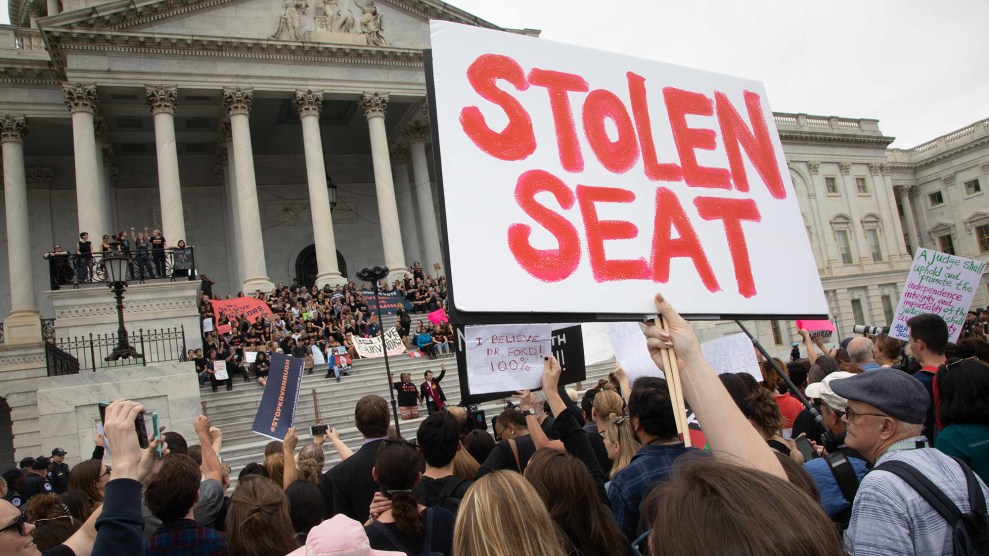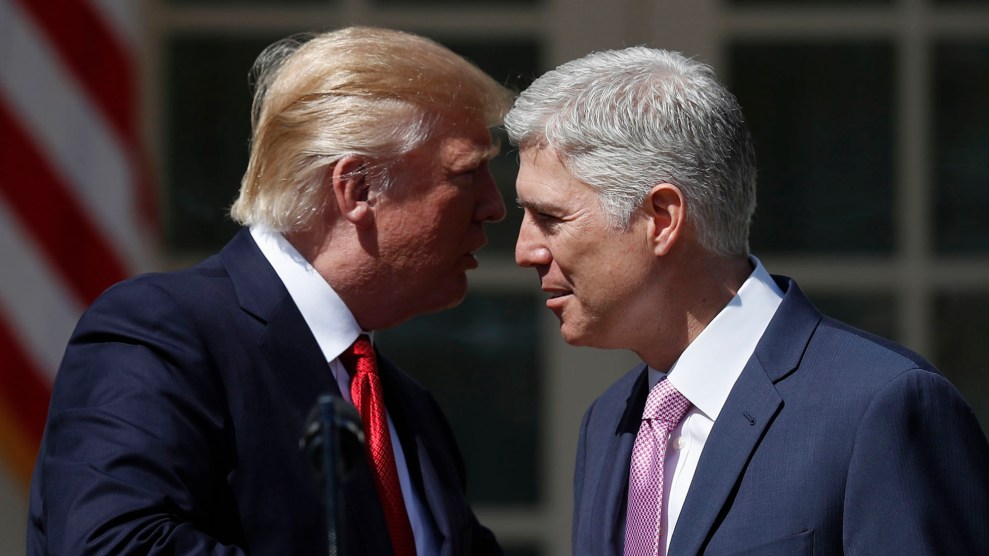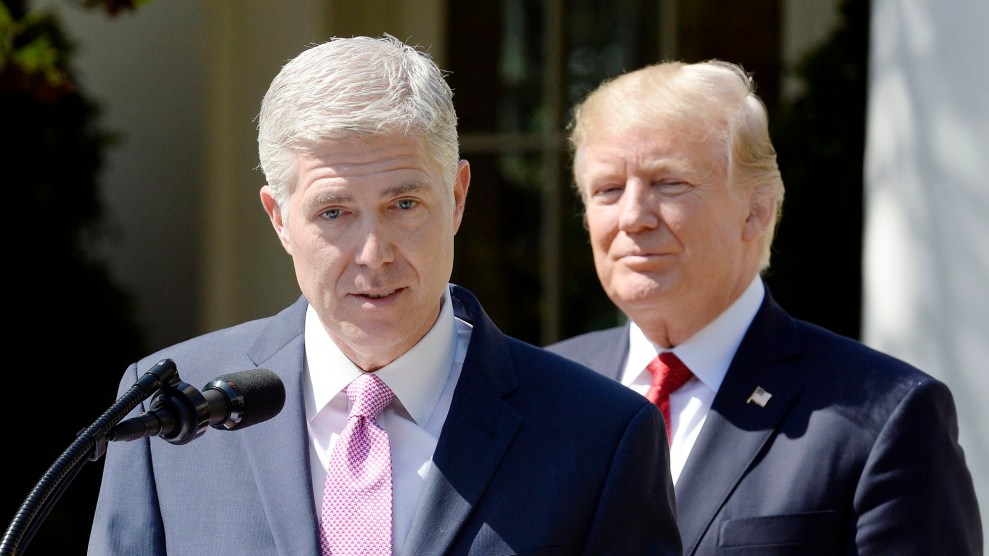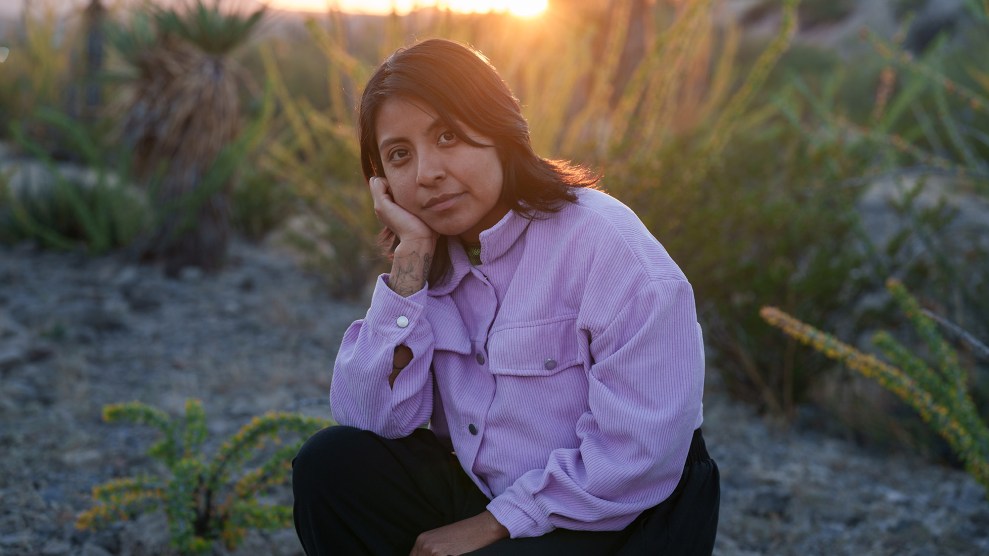
Protesters rally at the US Capitol hours before the Senate vote to confirm President Donald Trump's Supreme Court nominee Brett Kavanaugh, on October 6, 2018. Jeff Malet/Newscom via ZUMA
The whole thing started at a town hall in Philadelphia last month with Democratic presidential hopeful Pete Buttigieg, the mayor of South Bend, Indiana. When a member of the audience asked him if he would be willing to increase the number of justices on the Supreme Court if elected in 2020, Buttigieg didn’t shy away from what has been, since 1937, largely an untouchable subject in American politics. “I don’t think we should be laughing at it,” he said as the audience tittered in acknowledgment of the thorny nature of the question. “In some ways, it’s no more a shattering of norms than what’s already been done to get the judiciary to where it is today.”
Buttigieg’s answer invited more questions about court-packing, directed both at him and his rivals. On the progressive podcast Pod Save America, Buttigieg said the court was on a path to becoming “basically ruined by being a nakedly political institution.” He made the same point during a CNN town hall on March 10. Former Rep. Beto O’Rourke of Texas stated his openness to reforming the nation’s highest court, including perhaps adding judges, at a campaign stop in Iowa last week. In the last few days, Sens. Elizabeth Warren, Kirsten Gillibrand, and Kamala Harris have said they wouldn’t rule out expanding the court if elected president.
The debate has moved quickly, and partisan battle lines have already been drawn. President Donald Trump told reporters on Tuesday he opposed adding justices to the court. On Tuesday, Rep. Mark Green (R-Tenn.) announced he would introduce a constitutional amendment to lock the court at nine justices. “Schemes to pack the court are dangerous to the Founders’ vision of an independent judiciary that serves as a check on both the Executive and Legislative branches of government,” he tweeted.
There’s likely no going back on what is now a major theme of the Democratic primary and possibly the general election. Part of the debate is internal to the Democratic primary: To what degree is the court is a threat to Democrats’ progressive policy goals? And part of the debate is a battle with the GOP over defining the last several years: Which party is trampling democratic norms—the one contemplating adding seats to the court to alter its makeup or the one that, in 2016, kept a seat open in order to deny President Barack Obama an appointment to the court?
The steps that Republicans have taken to shape the Supreme Court over the past few years have led some Democrats to believe that it’s time to throw out the rule book and fight back. After the death of Justice Antonin Scalia in February 2016, Senate Majority Leader Mitch McConnell held his seat vacant for over a year so that Merrick Garland, Obama’s nominee, could not fill it. In 2017, McConnell and his GOP colleagues eliminated the filibuster for Supreme Court nominees in order to push through Trump’s first nominee, Neil Gorsuch. Last fall, Senate Republicans rushed Brett Kavanaugh to confirmation after allegations that he had committed sexual assault in high school. As a result, the nation’s highest court is firmly in the grasp of conservative judges for the first time in decades. But the battle over the Supreme Court is only the most visible conservative effort to shape the judiciary.
Sam Berger, a former policy adviser in the Obama White House who now works at the liberal Center for American Progress, argues that over the past four years, conservatives have engaged in a more subtle form of court-packing, not just on the Supreme Court but throughout the federal judiciary—first by stalling or denying confirmation to Obama’s nominees, then by pushing through Trump’s. In just over two years, Trump has filled 10 percent of the federal bench and 20 percent of appellate judges. If McConnell follows through on his threat this month to reduce the Senate’s allotted debate time per nominee from 30 hours to two, Berger says, Trump could end up appointing nearly a third of the judiciary before the 2020 election.
But the question to Buttigieg that set off the whole debate was not just a product of the times; it was also the product of politically savvy groups pushing the issue. The questioner was involved with a group called Pack the Courts, founded last year by the activist and academic Aaron Belkin. Through the town hall, Belkin was able to get the question before a presidential candidate in public and kickstart a conversation he was already beginning to have behind the scenes with candidates and their staff.
“I’m surprised the candidates have come to understand the case so quickly,” says Belkin, a political science professor at San Francisco State University. “I thought it would take a few more months to persuade them.”
This isn’t Belkin’s first longshot crusade. For 10 years, he advocated for the repeal of Don’t Ask, Don’t Tell, founding a nonprofit to conduct research and craft messaging to persuade lawmakers, the public, and even the generals that allowing gay troops to serve openly would not harm military readiness. For Pack the Courts, Belkin hired Sean McElwee, a 26-year-old social media whiz who helped popularized the idea of abolishing Immigration and Customs Enforcement, to do polling and research. Belkin recognized that the best way to introduce bold reform is in a crowded Democratic primary, with candidates eager to attract media attention and win over the party’s liberal base.
“The emergencies we are facing are so extreme that if you are going to run for president, it’s not enough to have policy ideas,” he says. “You have to explain how you are going to pass those ideas and then how you are going to protect those ideas from the courts.”
Of course, there are huge political risks to promoting a radical court-packing scheme, and some liberals warn against it. Last summer, as Justice Anthony Kennedy’s retirement led some progressive bloggers and academics to begin calling for court packing, Bob Bauer, the former White House counsel to Obama, urged them to give it up. It was a political loser, he warned in The Atlantic, inviting blowback from an electorate already wary of seeing trusted institutions politicized. It could also endanger American democracy: The actions of a Supreme Court packed with liberal appointees, Bauer warned, “would carry less authority, with unpredictable consequences for the rule of law.”
But some progressive legal groups hope that a discussion about court-packing and the court’s effect on progressive reform could achieve what they have failed to accomplish for years: elevate the Supreme Court as an issue that drives Democrats to the polls and exerts pressure on Democratic presidents and senators to prioritize judicial nominations. “The thing that’s really important about the current moment is that there is this growing attention and recognition that courts matter,” says Alicia Bannon, who advocates for reforms to state court systems at the left-leaning Brennan Center for Justice. “We can’t just win our fights at the ballot box. We can’t just pass good legislation. We also need to have good judges.”
Pack the Courts isn’t alone on its mission. Belkin has joined a growing chorus of progressive activists, Democratic operatives, and academics in calling for reforming the Supreme Court. Earlier this month, former attorney general Eric Holder said that if Democrats regain power in 2020, they should consider expanding the court to counter the effects of the blocked Garland nomination. A new crop of progressive groups support the idea, including Demand Justice, which was started last May by veterans of Capitol Hill and the Obama White House to try to get progressive voters to care about the judiciary, and the grassroots group Indivisible. These groups, and figures like Holder, have successfully pushed the 2020 candidates to take on a topic that was off limits because of the political lessons learned more than 80 years ago.
In 1937, President Franklin Roosevelt faced a political quandary. The conservative majority on the Supreme Court was knocking down his New Deal reforms nearly as rapidly as he signed them. Social Security and the National Labor Relations Act were poised to fall next. So he hatched a plan to add six justices to the court—one for each sitting justice over 70 years old—under the pretense that the nine old men on the court were too old to shoulder the responsibility of running the nation’s highest court. According to historian Jeff Shesol, the author of Supreme Power: Franklin Roosevelt v. the Supreme Court, it was the deviousness of the plan that shocked FDR’s advisers. Cloaking a scheme about ideology as one about infirmity, they believed, was sure to backfire.
And it did. History books portray the disaster for FDR over the court-packing scheme as a warning to future generations that reforming the Supreme Court will end in political ruin. In 1938, the Democrats suffered a historic defeat in the midterms, effectively ending FDR’s bold domestic agenda. But at the same time, the nine justices may have been cowed by the threat of court-packing, and they stopped overturning FDR’s key legislative achievements.
When Belkin set out to start his project last fall, the law professors, progressive advocates, and strategists he consulted with reminded him of FDR’s failure. If Roosevelt couldn’t do it after winning a landslide reelection and a supermajority in Congress, it couldn’t be done now. “What I said in response was that I think the public has over-learned the lessons of 1937,” he says. “Because another way to think about 1937 is that Roosevelt arguably saved the New Deal by credibly threatening to pack the courts.”
Aware of the stigma attached to court-packing, Berger wants to flip the narrative. “This isn’t a question about whether or not one party should initiate court-packing,” he says. “It’s about what we should be doing about the court-packing that is already occurring. That’s a fundamentally different question than what was presented to FDR.”
Not only did Belkin not shy away from the FDR comparisons; he decided to name his group Pack the Courts. “We’re going to have to deal with the FDR baggage,” he says. “By just embracing the term, you embrace that this is what needs to be done.”
It’s here that the progressive consensus forming around Supreme Court reform splinters. Belkin sees similarities to FDR’s struggle that he wants to embrace. The court in the 1930s was dismantling the New Deal and Roosevelt’s efforts to bring the country out of the Great Depression. In the near future, he foresees a similar scenario in which Democrats, if they win in 2020, pass bold reforms like a Green New Deal or Medicare-for-All, only to see the Supreme Court knock them down. To him, this isn’t just about righting the wrong done to Garland; it’s also about stopping climate change and successfully enacting progressive legislation.
But the candidates, and other progressive judicial advocates, don’t say the goal of reform is to support their agenda. Instead, they discuss it as an attempt to save the court from itself. Buttigieg has repeatedly framed the issue as one of the court’s legitimacy. “It’s not just about expansion,” Warren echoed, “it’s about depoliticizing the Supreme Court.”
The stated reasons for judicial reform tend to shape the proposals for how to reform the court. Academics who believe that the court is on the precipice of a legitimacy crisis—one that has been building since a 5-4 majority put President George W. Bush in the White House in 2000—have proposed reforms aimed at fundamentally changing the nature of the court. Law professors Daniel Epps and Ganesh Sitaraman have outlined two options for saving the court’s legitimacy in an upcoming Yale Law Review article and in Vox. One is to transform the court from a permanent court of nine to a rotating panel that randomly selects nine justices from a pool of federal judges every two weeks. The other, which Buttigieg and O’Rourke have expressed interest in, would create a court of 15: five picked by Democrats, five picked by Republicans, and five chosen by the unanimous consensus of the 10 Democratic and Republican justices. Other academics have proposed term limits.
Then there is Holder, in a separate camp, who suggested adding seats to the court not so much to carry out a needed reform, but as to exact eye-for-an-eye justice to counteract the Republicans who denied Garland a seat on the bench.
Most outside groups are hoping to find the best approach over the course of the campaign and have not endorsed any specific proposals. But Belkin is adamant that the only route is simply to add judges—ideally four of them. There is nothing in the Constitution limiting the Supreme Court to nine justices. The other proposals, by contrast, are likely unconstitutional, he argues, so they would be struck down in court if passed by Congress and would require a constitutional amendment. If Belkin’s first step was to get the candidates to embrace reform, the next is to convince them to abandon the academic debate and use brute force to pack the court.
“The emergencies we’re facing are so dire that we don’t have time to have a multi-year conversation about the nuances of this judicial reform package versus that judicial reform package,” he says. The only option, as he sees it, is to pick the option least likely to be struck down by the court he is trying to alter. And that’s FDR-style court-packing.


















